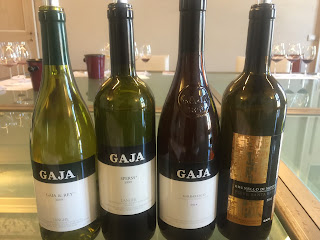The table below shows the range of Gaja Langhe offerings at
the point of my first visit a little less than 5 years ago.
In the table, five of
the Nebbiolo wines are labeled Langhe Nebbiolo DOC. Angelo felt that a 100%
Nebbiolo required bolstering to measure up to his vision and, to that end,
added small amounts of Barbera to round out the wines. These additions meant
that the wines could not be labeled DOCG. After seeing the
quality of grapes that have become almost the norm in the Langhe in recent
years, Angelo has made the decision to produce his wines to the DOCG
specs beginning with the 2015 vintage.
The cellar is divided into three parts: (i) Fermentation
cellar – all stainless steel tanks; (ii) first-year aging – barrique and
tonneau, all French oak, and up to 20% new (first-, second-, and third-year passage);
and (iii) second-year aging – large oak casks, Austrian and Slavonian oak.
This was my second visit to Gaja and the notes on the wines
that I tasted on my initial visit can be found here. On this visit we tasted
three Langhe wines and one from Montalcino. The notes from the most recent tasting
follow.
The first wine tasted was a 2012 Pieve Santa Restituta Brunello di Montalcino. The estate generally draws fruit from
south-and north-facing slopes but with the warm temperatures, the south-facing
vineyard produced overripe fruit. The wine was opened the morning of the
tasting. Sweet, dark, juicy fruit with attractive tannin levels. A food wine. Austere,
smoky finish.
The Barbaresco 2014
was opened the day prior to the tasting. Not very concentrated (Sarah talks
about a Burgundian style). Sweet, pale fruit with hints of carbonic maceration.
Florality. Tar. On the palate strawberries, cherries and aggressive tannins.
The Sperss 1999
showed oak and sweet fruit, tobacco, rust, blackpepper, and a savoriness. Rose
tar and spice on the palate. Richness and laid-down tannins.
The Gaia&Rey 2009 showed sweet fruit, oak and baking
spices. Curry and tropical fruit. Utilized whole-bunch fermentation in this
ripe vintage. Never tried it again. And I can understand why.
©Wine -- Mise en abyme




No comments:
Post a Comment